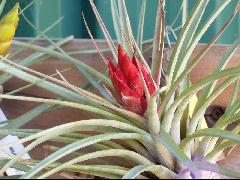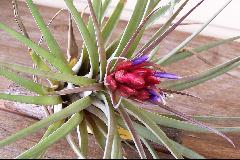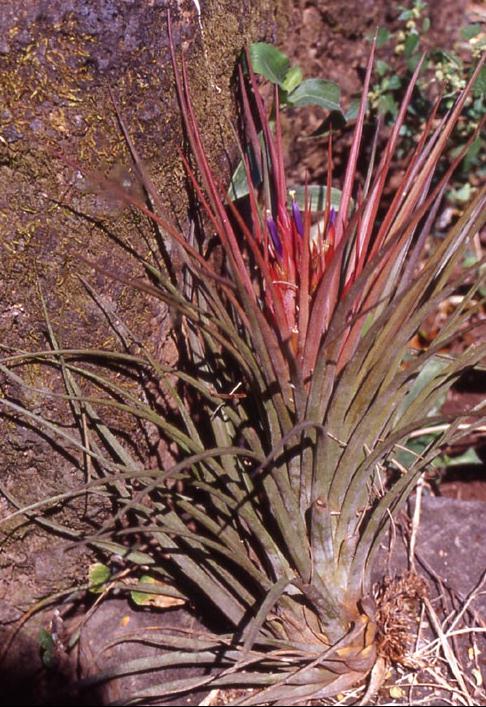


This plant became a Tillnuts discussion when Mark Supple of Newcastle showed a photo of a flowering plant of his called T. fasciculata ‘Minor’. As you all know, I shudder at the use of this adjective because it means there are differences between this plant and the species but nobody has bothered to define what these differences are. The advantage of Tillnuts is that we are all terrible poker players and love to show our hand so others can get involved. This was no exception where it appears this plant started its Australian life in the 1980’s when Hal Ellis from Victoria was importing plants with Garry Thompson. As is usual, offsets get exchanged and Chris Larson was not happy with the name ‘minor’ and started investigating. He even cornered Renate Ehlers at the Adelaide Conference in 1995. It was felt that the plant could be Rauh’s T. nidus which was still a somewhat unknown quantity at that time. Nothing further was done other than Chris and Maurice Kellett changing their name to T. nidus.
For the first time we will now show what Rauh said in 1983 but in English!
Tillandsia nidus - Rauh & Lehmann, Trop. Subtrop. Pflanz. 41: 19-22. 1983
Plant stemless, flowering to 20cm high, Leaves numerous, narrow, erect, occasionally secund, making a large rosette 5 – 6cm diam.
Leaf sheath indistinct, ca 3cm long, 1.4cm wide, pale brown lepidote.
Leaf blade erect, narrow triangular, to 20cm long, 1.4cm wide near sheath, channelled, long attenuate, green, dense grey lepidote.
Scape very short, 2 – 3cm long, 4mm thick.
Scape bracts 2 – 3, membranous, ca 2cm long, much shorter than the primary bract.
Primary bract leaflike, erect, the bottom ones with its sheath as long as the spike with long filiform dense grey lepidote blade, the upper ones shorter.
Inflorescence nestling, exceeded by the leaves, 8 – 10cm long, 5 – 8cm wide, densely bipinnate, with 10 – 14 erect, complanate, short stemmed, 4 – 5cm long, 1.5cm wide, ca. 5 flowered spikes.
Flower bracts densely imbricate, ca. 4cm long, 1.2cm wide, keeled, with short hooked tip, membranous, carmine red, at the bottom green, laxly lepidote, smooth, (when dry strongly nerved) much exceeding the sepals.
Sepals 25mm long, 6mm wide, acuminate, keeled, membranous, free, reddish at tip, otherwise whitish.
Petals 4cm long, 3mm wide, pale violet with white edges and a blunt weakly reflexed tip.
Stamens and Style protruding. Filament 22mm long. anther 7mm long.
Ovary 7mm long.
Habitat central Mexico without exact location.
Holotype BGH 46 409 in Heidelberg (HEID)
T. nidus had already been known for a long time by J. Zehnder, Kaktimex, Switzerland, without collection data and reached Dr. J. Rutschmann, Basel, as T. diguetii Mez on the basis of the nesting, deeply inserted inflorescence in the leaf rosette, and was sent to the collection in the Botanical garden Heidelberg. As such, it was published as a colour photograph by Rauh in the Journal of The Bromeliad Society Vol. XXXI, No., 5, 1981, pages, 218-219. Investigation has yielded however that it is not T. diguetii, because this plant resembles a young T. seleriana Mez with sessile inflorescence and amongst other things the base of the leaf rosette is a pseudo-bulb. Compared to T. nidus, T. plagiotropica Rohweder, has a flat spreading rosette ( fig. 9).
T. nidus may be one of the many natural hybrids, that have recently become known from Mexico.
Note – no mention made of reddening in the centre at anthesis.
Things have moved on since then because the next reporting we got was that De Rebus I, 1994 indicated this was a natural hybrid of fasciculata x ionantha. Note that we still did not know where it could be found in the wild! We do know that by 1997 Birdrock had it in their catalogue but no location. We do know that Renate Ehlers collected the plant in 2006 near Coatepec in the State of Vera Cruz, Mexico. We do know that with natural hybrids, back crossing occurs making it difficult to know what range this hybrid might have.
This then is what we know about the plant in the wild but can we link a plant imported in the 1980’s to T. nidus or T.xnidus? The safer option is to give this clone the name of T. ‘Hal’s Nidus’ and to use Mark Supple’s photo as an example. The reason why I picked the name is that if your plant can be traced to Hal Ellis or has a suspect name like ‘nidus’ you can at least follow the threads. There are certainly other plants that look similar to this plant and have doubtful pedigree which could be linked to ‘Hal’s Nidus’ but that is the decision of the owners.
As for the future where someone is trying to identify a plant at least we have photos of what we consider typical T. fasciculata, T. nidus and T. ‘Hal’s Nidus’
Late addition, from Derek Butcher -
Originally acquired as T. 'Seaborn' from a South Aussie, who got it from Qld, which is as far as the provenance goes.
Who else is growing this plant?


